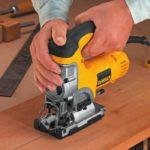You must have a track saw, or a circular saw in your workshop. Why don’t you become a hobbyist or professional woodworker? Usually, a track saw and a circular saw look almost similar. Both the track saw and circular saw come with a powerful motor and a circular blade also can perform straight line and angled cuts.
In today’s write-up, track saw vs. circular saw comparative, we’ll be having an in-depth discussion of both powerful tools to identify which one is best for you.
What is track Saw
A track saw is a type of saw that has a long straight cutting blade mounted on a wooden or metal rail. It has a mechanism to move the blade from side to side and forward and backward, which allows it to cut through the wood.
Simply put, it is a circular saw attached to a precise metal track. It is also known as plunge saw or plunge-cut. You can find out more information What Is A Track Saw Used For?
What is Circular Saw
On the other hand, a circular saw is a saw that uses a circular blade to cut through wood. The blade spins around the axis of the saw, cutting wood in a circular motion.
Circular saws are typically used for cutting lumber and other materials, such as plywood. The blade is mounted on a frame that supports the blade and holds it in place while it spins. It’s usually powered by an electric motor that runs the blade at high speed.
Track Saw Vs. Circular Saw: Which One is Best For You?
There’s always a debate on the topic: Track saw vs. Circular saw. Both saws are very well known for their various usage. However, which one to choose depends on different things.
That’s why here we’ve enlisted some of the factors.
- Blade Size
- Depth Settings
- Speed Settings
- Bevel Capacity
- Ergonomic Handle
- Motor Power
- Track Length
- Safety Feature
- Score-Cut Settings
- Soft Start
- Dust Collection System
Blade Size: Saw performance depends on it
An average track saw blade is around 6.5 inches long. A riving knife is included with certain track saws. Using this knife, the saw doesn’t kick back and injure the user.
With a circular blade, you have a wide range of options to choose from. Unlike a track saw, the blade is constantly visible from the front.
Depth Settings: Indicates the thickness you can cut
The majority of track saws have 6.5-inch blades and can cut materials up to 2 inches thick. Track saws with 8.25-inch or bigger blades can cut through material up to 2.75-inch in thickness.
Compared to the track saw, the depth of the Circular saw blade should be adjusted such that it only passes through the bottom of the workpiece by roughly 1/8” to 1/4.” If you leave too much of the blade exposed, you put yourself at risk for a severe wound.
Speed Settings: Increases work accuracy
When it comes to circular, saw it’s better to set the speed between 1173 to 1500 rpm cause if you increase the speed, the blade can become unstable and create a hazardous situation.
On the contrary, you’ll get a precise cut from a track saw with a speed of 2000rpm to 5000rpm.
Bevel Capacity: Allows special types of cuts
As a woodworker, having a track saw that can create bevel cuts is a great asset, as it allows you to work on a wide variety of projects. A track saw with a bevel range of 0° to 45° will be sufficient for your purposes.
But a circular saw can create basic bevel cuts up to a maximum angle of roughly 55 degrees. A movable base plate is used to do this.
Ergonomic Handle: Let's work for a long time
When it comes to holding a saw, a circular saw stands over a track saw. It’s because the design of a circular saw’s handle is very comfortable and flexible that it won’t sore your arm.
Motor Power: It expresses the power to do so.
When shopping for a saw, be sure to consider the power of the engine. Wood or any other material may be sliced through at a faster pace by the saw.
Powerful motors are essential for a track saw. Nine amps is a minimum requirement for motor strength. There’ll be no precise cuts if the motor is underpowered.
Track Length: keep easier for long cutting task
The length of the tracks varies from one manufacturer to the other. Extensions may be used to increase the length of a short track.
Because of this, it’s always preferable to have a lengthy, uninterrupted single track. When working in confined locations, a longer track may be an impediment.
Safety Feature: Protects workers from injury
The track saw’s blade is less apparent and exposed than the circular saw’s, despite both saws employing circular blades. Instead of an externally spinning blade, the blade is contained inside the saw’s gear.
Score-Cut Settings
Score-cut settings are useful when dealing with materials that chip or splinter easily. It’s possible to have a splinter-free cut throughout the whole length of the kerf rather than just on one side by scoring the material first.
This is a time-saving function instead of coming back after the cut to fix it up afterward.
Soft Start: Helps to adjust the cutting task
Using a soft start is a fantastic safety feature since it prevents kickbacks caused by the saw’s torque during start-up.
The gentle start feature prevents the machine from jerking to life when it starts up. This safeguards the engine, gears, and bearings. The soft-start can be installed on any brushed motor with a 230 V supply voltage.
Dust Collection System: Keeps your work space clean
Usually, every track saw comes with a dust bag where all the dust gets stored without any mess. You can even store the bag by folding it when you’re not using the bag.
However, on the other side, the circular saw has no dust bag. So whenever the blade is working, it throws all the cuttings, which can be a huge mess.
Can any circular saw be used as a track saw?
Yes, any circular saw can be used as a track saw. You can cut the wood with a circular saw. However, the results will not be as accurate as with a track saw.
The reason is that a circular saw will not be able to make clean cuts. Track saws are designed to cut accurately and consistently and offer an excellent cutting angle.
A track saw will allow you to make clean cuts with more precision than you can achieve with a circular saw.
When Should I Use a Track Saw?
You should use a track saw when you want to cut a long straight piece of wood, such as a board for a door.
Track saws are great tools for woodworkers, carpenters, and other tradesmen. They allow you to cut through material much faster than with a traditional hand saw. The only drawback is that they can be more dangerous than a traditional saw, so it's important to know when to use them.
If you’re cutting a board that’s already been shaped, you can just use your circular saw.
Can I use a Track saw without Track?
Track saws can be used without a track. The blade of the saw can be set in place, and it will cut through the wood.
This can work if you are cutting a straight line, but it is not recommended if you are trying to cut a curve. The blade will only follow the line that you have drawn, and it will leave the side of the wood.
in a final note
To finally conclude between track saw vs circular and which one is better is tricky. It's not that both are the same, but each of them has their own use cases. This does not implies there’s no winner in between them?
The answer is yes, and truck saws are better since their use cases are more versatile than circular ones.
Track saw is multifunctional and can be used for cutting wood, metal, and other materials. It has a powerful motor that can easily cut through any material whereas a circular saw cannot be used in so many ways.





